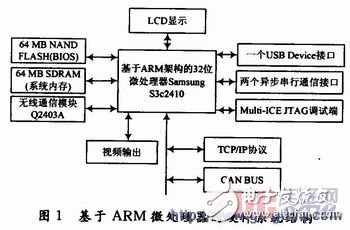With the continuous development of the internet era, the web has become a fundamental infrastructure for information sharing. More and more devices are now required to connect to the internet. For embedded intelligent systems such as PDAs, wireless communication is essential. One common way for household appliances to access the internet and achieve smart functionality is through dial-up connection. Among various network access methods, dial-up remains one of the most cost-effective and practical options, especially when connecting to an Internet Service Provider (ISP). The primary data link layer protocol used in this mode is Point-to-Point Protocol (PPP).
This paper delves into the PPP negotiation process during dial-up internet access, thoroughly explores the design of a network dialing program, and validates its implementation on an embedded hardware platform based on an ARM9 processor.
**1. System Hardware Platform Construction**
The system uses the S3C2410X chip, which is built around the ARM920T core. This 32-bit embedded RISC microprocessor is designed for handheld devices and applications that require cost-effectiveness and low power consumption.
For wireless communication, a GPRS module is employed. Specifically, the Wavecom Q2403A is a wireless modem that operates over the GPRS network. It supports voice calls, SMS services, and data transmission. The Q2403A provides multiple interfaces, including power connectors, LCD ports, SIM card slots, charging ports, headphone jacks, microphone inputs, and other specialized peripheral interfaces. When sending data via GPRS, the download speed reaches 26.8 Kb/s, while the upload speed is 13.4 Kb/s. The overall hardware structure of the system, based on the ARM microprocessor, is illustrated in Figure 1.

**2. Network Dial-Up Connection Process**
In this article, GPRS is used as an example to explain the specific steps involved in establishing a network dial-up connection. Network dial-up access involves creating a PPP connection and using GPRS for data transmission. The PPP link establishment process consists of three main stages: link creation, authentication, and network negotiation.
(1) **Establishing the PPP Link**
The Link Control Protocol (LCP) is responsible for setting up the link. During this phase, the basic communication method is determined.
(2) **User Authentication**
At this stage, the client sends its credentials to the remote access server. A secure authentication method is used to prevent unauthorized access, data theft, or impersonation. The system cannot proceed to the network layer until the authentication is successfully completed. If the authentication fails, the system will move to the link termination phase.
Commonly used authentication protocols include the Password Authentication Protocol (PAP) and the Challenge Handshake Authentication Protocol (CHAP), along with the Internet Protocol Control Protocol (IPCP).
(3) **Negotiating the Network Layer Protocol**
Once the authentication is complete, the PPP protocol invokes the Network Control Protocol (NCP) selected during the link creation phase. This NCP handles higher-level protocol issues on top of the PPP link. For instance, the IP Control Protocol (IPCP) can assign dynamic IP addresses to users who dial in.
After completing these three stages, a fully functional PPP link is established, enabling stable and secure internet access.
110KV, 220KV Oil-resistant Heat-shrinkable Tubing
110KV, 220KV oil-resistant heat-shrinkable tubing
110KV, 220KV oil-resistant heat-shrinkable tubing,Heat-shrink tube,Heat shrinkable tubing,thermal contraction pipe,Shrink tube
Mianyang Dongyao New Material Co. , https://www.mydyxc.com
